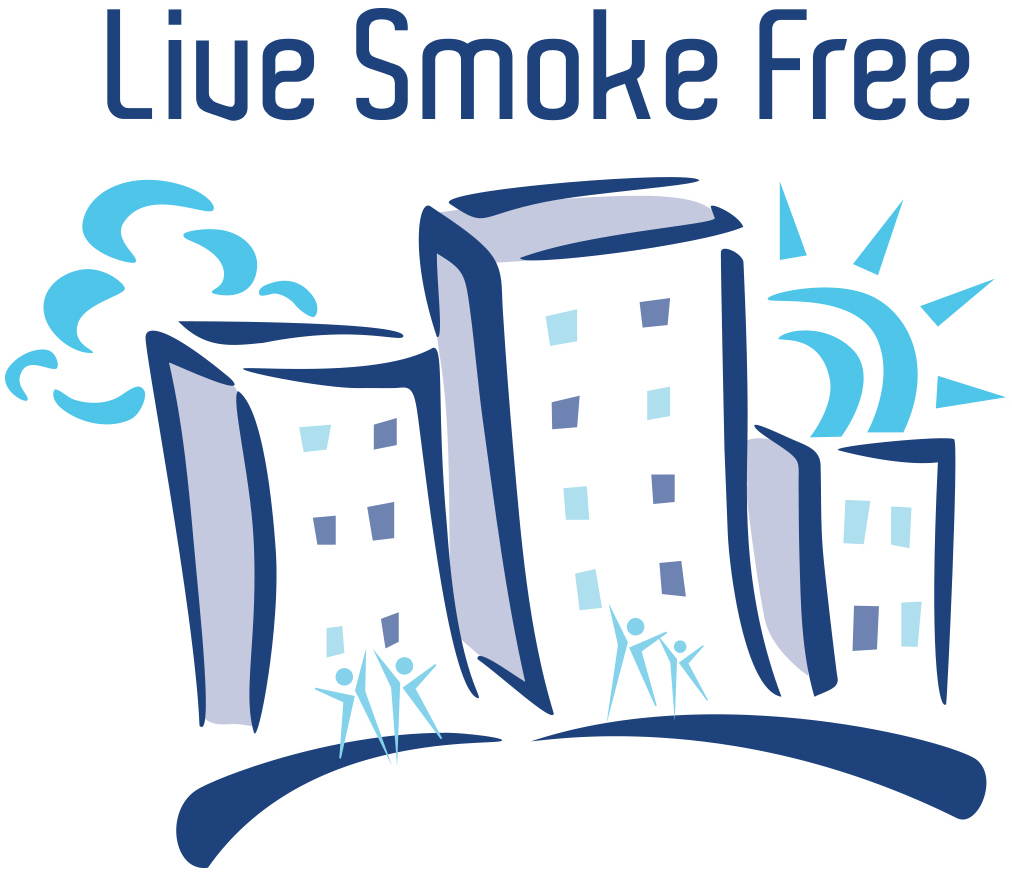PROPERTY MANAGERS
Are you an owner or manager of affordable housing? We’ve got additional resources for you on our Affordable Housing page.

Smoke-Free Multi-Housing
Smoke-free housing policies are easy to implement, legal to adopt and can improve a manager’s bottom line. Are you considering adopting a policy for your multi-unit buildings? Find answers to your questions here, and get the materials and resources you need!
Live Smoke Free has materials to walk you through the whole smoke-free policy adoption and implementation process.
Building Signage
Utilize our FREE signs and resident reminders to help communicate your policy to guests and remind your residents. These Common Area Signs and Clings are available to any Minnesota property regardless of whether or not they are smoke free.
*For MN properties only
The following signs and promotional materials are available to any Minnesota property that has a smoke-free policy. Before you order, please read all of the considerations listed under the link to the order form.
Window/ Door Clings
- Window/ Door Cling (English Only)*
- Window/ Door Cling (English/ Spanish)
- Window/ Door Cling (English/ Hmong)
*pictured right
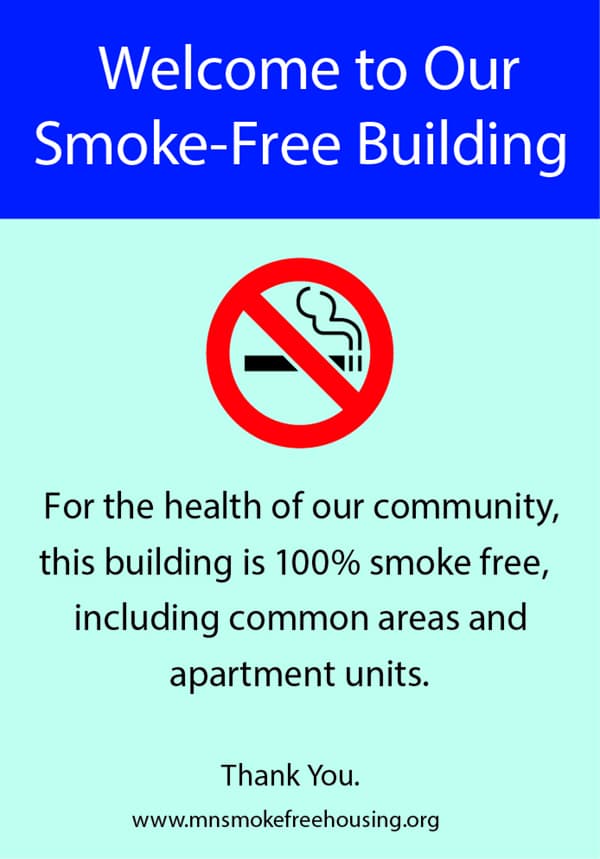
Outdoor Metal Signs 12″ x 18″
- Smoke-Free Building
- Smoke-Free Building (includes electronic cigarettes)*
- Smoke-Free Property
- Smoke-Free Property (includes electronic cigarettes)*
- No Smoking Beyond This Point (establishes a smoke-free perimeter)
*Electronic cigarettes must specifically be mentioned in your smoke-free policy to receive those signs.
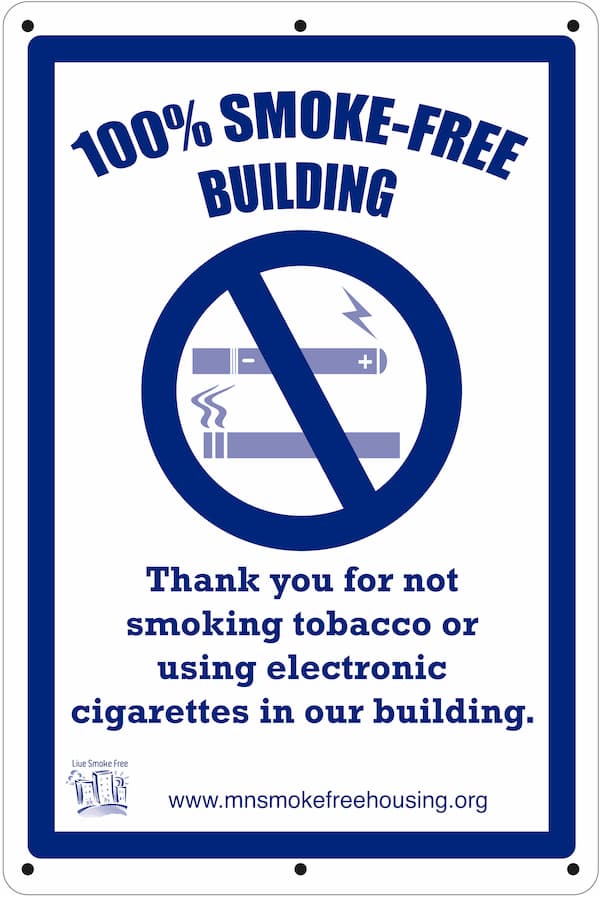
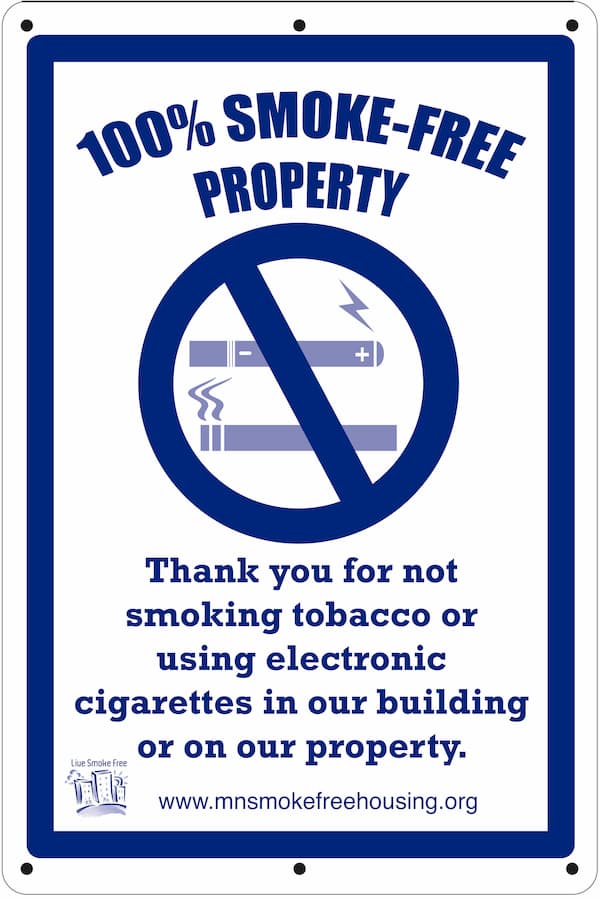
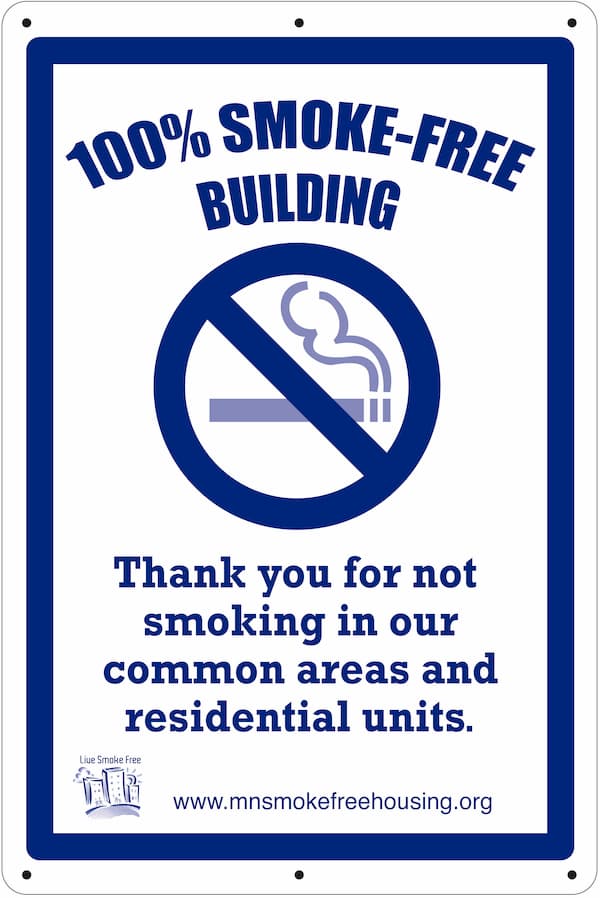
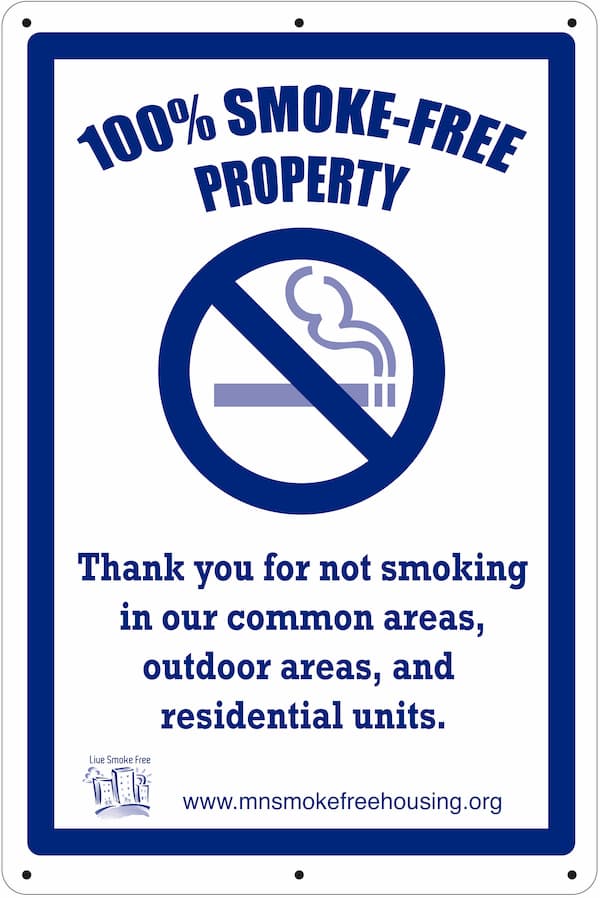
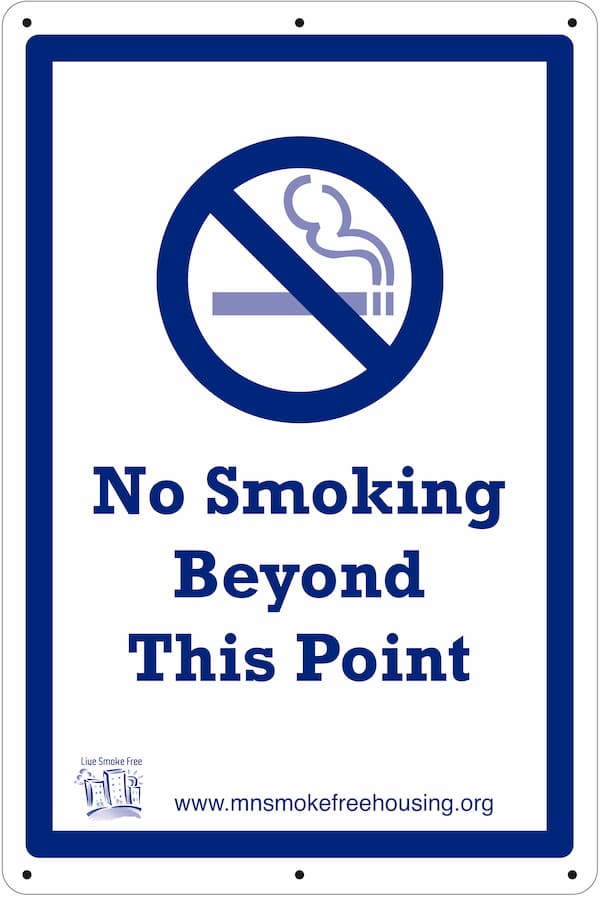
Individual Unit Door Sign 3.5″ x 5″
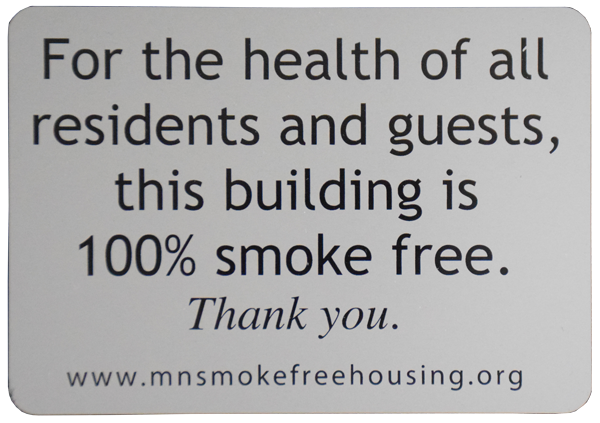
Resident Reminders
- Key Chain
- Magnetic Notepad
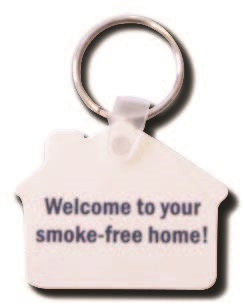

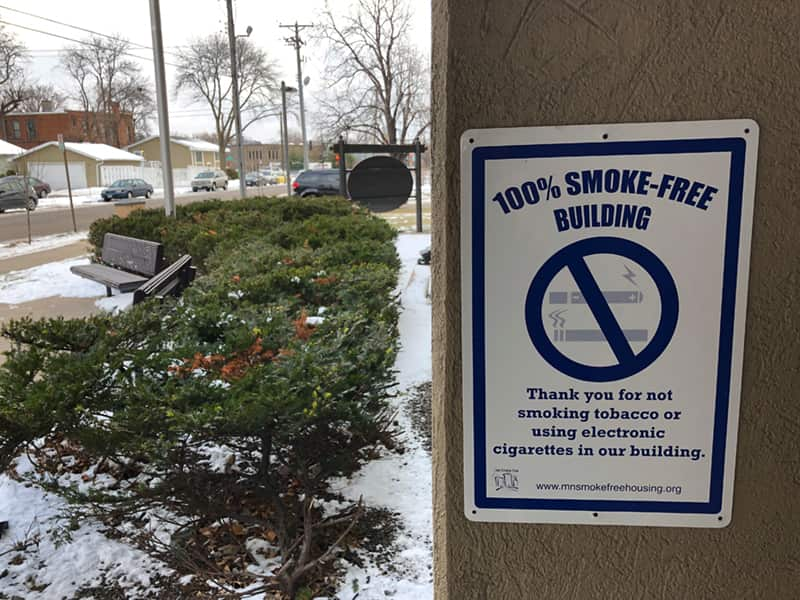
To order free signage
*For MN properties only
Additional Information:
- Smoke-free policies must cover a minimum of 100% of the indoor areas to receive our signs.
- Orders won’t be filled without a copy of the smoke-free policy.
- Live Smoke Free reserves the right to limit the size of an order based upon available materials.
- Please allow 2-3 weeks for shipping.
- For inquiries outside of MN click here.

Policy Adoption Materials
Here are materials to help you adopt a smoke-free policy for your building and/ or property:
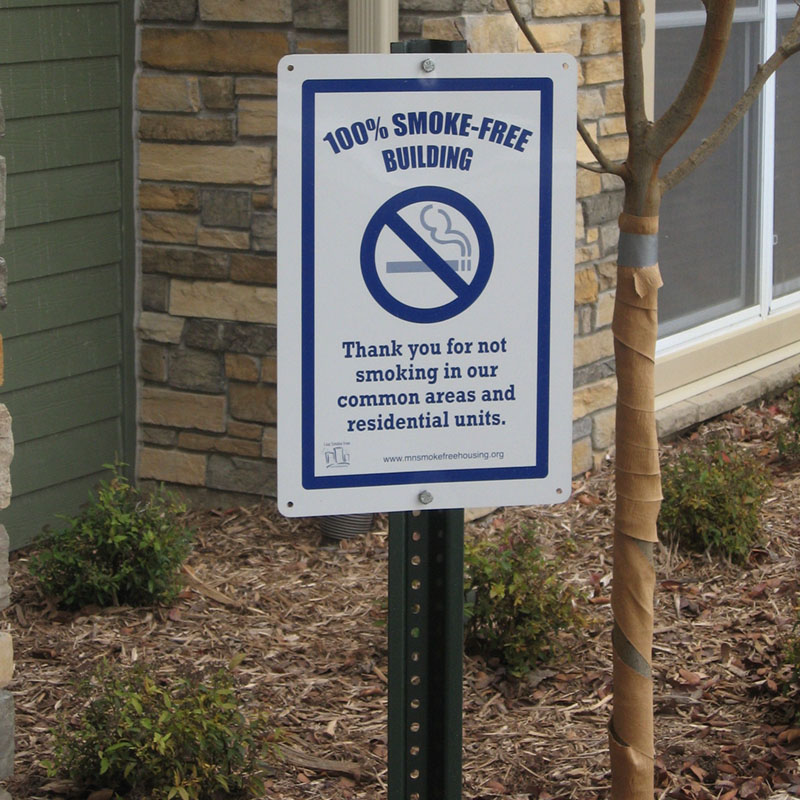
Promotions
Now that you have a smoke-free building, promote it!
Add your smoke-free buildings to the Minnesota Smoke-Free Housing Directory. All renters who call the Live Smoke Free office looking for smoke-free housing are referred to this site; it receives 3,000+ views a month. Let us help you promote your smoke-free building. Sign Up to create a free account today.
Don’t forget to list your smoke-free policy as an amenity in your other listings and on your property website.
For other promotional materials and tips, visit our section about smoke-free policy promotion below.
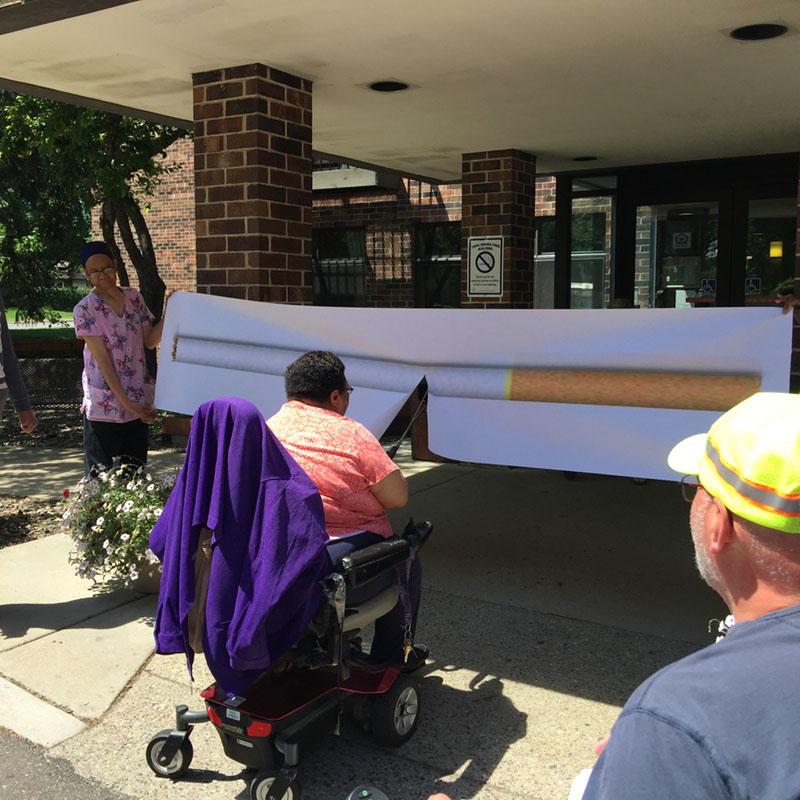
Adopting a Smoke-Free Building Policy:
A Three-Part Series for Apartment Managers
Apartment managers and owners often go through three stages when adopting a smoke-free policy. Live Smoke Free has designed these materials to meet the needs of managers and owners whether they are in the stage of contemplation, adoption, or implementation.
These steps represent folders of information that Live Smoke Free has available. If you would like to receive hard copies of the folders and their contents, please contact Live Smoke Free. For smoke-free housing programs who are inspired by our work, we ask that you contact us prior to reproducing, modifying or sharing our work, and that you credit us for the initial creation of these resources; we are very proud of the hardwork and creativity that went into making these resources.
If you are looking for information on adopting a policy in condominiums, townhomes, or other owner-occupied common interest communities, please visit our common interest communities tab.
Click on any of the steps below to learn more about the contents of each folder.
Are you interested in adopting a smoke-free policy for affordable housing? Check out some additional resources on our Affordable Housing page.
Steps to go Smoke Free
Live Smoke Free staff and materials are available for you to utilize when transitioning to a smoke-free building.
Live Smoke Free has organized the resources and materials that you may need for these steps into a Three-Part Series for Apartment Managers. If you would like to receive hard copies of the folders and their contents, please contact Live Smoke Free. For smoke-free housing programs who are inspired by our work, we ask that you contact us prior to reproducing, modifying or sharing our work, and that you credit us for the initial creation of these resources; we are very proud of the hardwork and creativity that went into making these resources.
Association boards of common-interest communities go through similar steps when adopting a smoke-free policy as their counterparts in rental properties. Visit our common interest communities section learn more.
If you are adopting a policy for affordable housing, visit our Affordable Housing page for more resources and considerations.
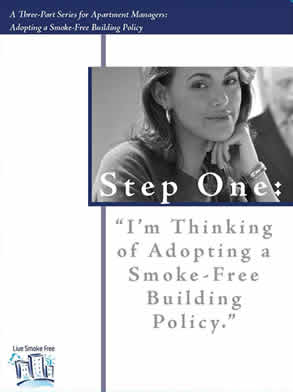
Step One:
“I’m Thinking of Adopting a Smoke-Free Building Policy”
This is a first look to understand the benefits and steps to adopting a smoke-free policy. This step provides informational fact sheets, and a sample resident survey.
The materials below can be applicable to all rental properties. If you own or manage a housing authority or subsidized property, you may also find the materials for “Adopting a Smoke-Free Building Policy for Affordable Housing“ useful.
Introductory Materials
- Table of Contents
- About Live Smoke Free
- “Adopting a Smoke-Free Building Policy: A Three-part Series for Multi-Unit Housing Managers and Assistance for Homeowners Associations” Handout
- “An Apartment Manager’s Guide to Adopting a Smoke-Free Building Policy” 8-page booklet
- Profile of a smoke-free apartment building (contact us if you would like profiles from other properties)
Fact Sheets
- Fact sheets on research conducted in Minnesota and the Twin Cities around renters’ interest in smoke-free apartments:
- “Damage from Cigarette Smoke Reside” Fact sheet on the the damage caused by smoking residue
- “Up in Flames” Fact sheet on the dangers of smoking-related fires in apartment buildings
- “Freedom to Breathe in Rental Apartment Buildings” Fact sheet from the Minnesota Department of Health on the current laws regarding smoking in apartment buildings
Articles
- “Clearing the Air” Article in Units Magazine published by the National Apartment Association
- “A Breath of Fresh Air” Article in Units Magazine published by the National Apartment Association
- “Property Management Update” Article by the National Multi-Housing Council on smoke-free policies
- “Infiltration of Secondhand Smoke into Condominiums, Apartments and Other Multi-Unit Dwellings” Law Synopsis
- “Secondhand Smoke: What it Means to You” Summary of the 2006 Surgeon General’s Report
Sample Documents and Tools
- Sample survey to give to residents to assess desire for a smoke-free policy (pdf) (Word document)
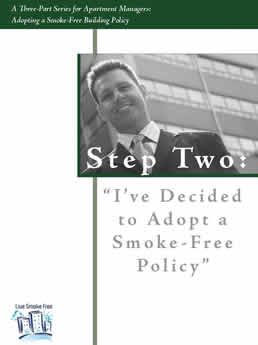
Step Two:
“I’ve Decided to Adopt a Smoke-Free Building Policy”
Once owners and managers decide to adopt a policy, they must notify the residents of the policy change and begin to implement the policy. This step includes a customizable letter to notify residents of the policy change, checklists and timelines for policy adoption guidance, and a model smoke-free lease addendum. An order form to receive smoke-free building signs, and cessation referral information is also included.
Includes the sub-topic “Enforcing Your Building’s Smoke-Free Policy.
Methods for Adopting a Smoke-Free Building Policy
- “Phase-In” Method: Begin having new renters who move into the building sign a smoke-free lease addendum immediately. Announce the policy change to current residents and have them sign a smoke-free lease addendum at the time of their lease renewal.
- “Quit Date” Method: Decide what date you would like the building to go smoke free. Give your residents proper notification of the policy change and tell them that they must sign a smoke-free lease addendum if they wish to continue living in the building.
These materials will help you implement your smoke-free policy:
Introductory Materials
Fact Sheets
- “Notice Requirements for Implementing a Smoke-Free Policy” Fact sheet
- Policy adoption timelines and checklists (pdf)
- “Addressing Safety Concerns During Smoke-Free Policy Implementation” Fact sheet
- National and Local Cessation Resource sheet
Sample Documents and Tools
- Sample letter to notify residents of smoke-free policy change (pdf) (Word document)
- Model smoke-free lease addendum (English)
- Model smoke-free lease addenda in
- Order form for smoke-free policy implementation materials
- Order form for smoke-free common area signs
To view images of these materials, please visit our materials page.
“Enforcing Your Building’s Smoke-Free Policy”
By enforcing your smoke-free policy, you are showing all of your residents that you believe in the importance of the policy and the importance of protecting them from secondhand smoke. Enforce your smoke-free policy the same way you would enforce current building policies. In some cases, that could mean verbal warnings, written warnings, or possible eventual termination. Live Smoke Free recommends using an equitable, graduated approach to enforcement.
- Enforcing a smoke-free policy in an apartment building Fact sheet
- Enforcing a smoke-free policy in public housing Fact sheet
- Smoke-Free Housing Help: Resources for Minnesota Property Managers and Residents
- Notice of Smoking Incident form (complaint form to be filled out by resident and given to manager notifying the manager of a neighbor’s violation of the smoke-free policy) (pdf) (Word document)
- Notice of Infraction form (complaint form to be filled out by manager and given to a resident who is in violation of a policy) (pdf) (Word document)
- Notice of Smoke-Free Violation form (form to be filled out by manager and give to a resident who is in violation of the smoke-free policy) (pdf) (Word document)
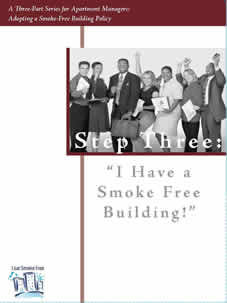
Step Three:
“I Have a Smoke-Free Building!”
After a smoke-free policy is implemented, there are many free resources available to managers and owners looking to capitalize on having a smoke-free property. This folder includes login informaiton for our free smoke-free directory, publicity tips, and promotional materials order forms.
Includes the sub-topic “Promoting Your Smoke-Free Apartment Building.”
Thank you for protecting the health of your residents by adopting a smoke-free building policy! You have made a smart decision that will protect your investment in your building and the health of your residents.
You may have already noticed that smoke-free policies lead to buildings that are healthier, safer and cleaner. Browse the materials in “Promoting Your Smoke-Free Apartment Building” to discover ways in which you can market your building to prospective residents!
We look forward to helping you promote your newest amenity: smoke-free air!
-
Sample certificate of recognition from Live Smoke Free (contact our office for a customized certificate)
- Create a Manager’s Account and list your building on our smoke-free directory
Order Forms
- Smoke-Free Policy Implementation Materials Order Form (online Ι PDF)
-
Smoke-Free Common Area Signs and Clings Order Form (online Ι PDF)
“Promoting Your Smoke-Free Apartment Building”
Your smoke-free policy is an amenity that renters are looking for! Promote your smoke-free policy just like you would promote a pool, fitness center, or underground parking. Contact Live Smoke Free to learn more about how we can help you create a customized promotion plan for your smoke-free policy.
- Publicity Packet: Advertising and Marketing Your Smoke-Free Multi-Housing Policy Includes information on:
- Free signs and trinkets from Live Smoke Free
- Advertising through magazines and newspapers
- Utilizing apartment search services in Minnesota
- Unique promotional campaigns
- Advertising in community locations
- Hosting a community celebration
- Writing news and newsletter articles
- A sample press release
- Advertise with a local pizza company (pdf) (Word document)
- Bookmarks
- Web banner ads
- Phone number tear sheet (pdf) (Word document)
- Sample press release (pdf) (Word document)
- We Are Smoke Free (flyer to hang in your building) (pdf) (Word document)

What is Your Situation?
Are you planning for new construction?
A smoke-free policy can help maintain the building’s clean condition and protect your investment from day one.
Are you renovating your building or purchasing an older building?
A smoke-free policy can help protect all of the hard work and money you may be putting into new carpet, paint, or fixtures.
Are you moving ahead with a policy with no other changes to your building?
Many managers adopt a smoke-free policy without renovating or doing major changes to the building.
Who determines policy decisions for your building?
Talk to the building’s owner or other key decision makers about the benefits of going smoke free.
Decide which areas the policy will cover:
- Individual units: Covering all residential units ensures that smoke cannot drift from one unit to another unit in the building.
- Outdoor areas: Depending on your situation and location, you can choose to allow smoking in all outdoor areas, only allow smoking in designated outdoor areas, or prohibit smoking in all outdoor areas. Limiting or prohibiting smoking outdoors can help reduce smoke drifting into windows and reduce tobacco litter on your property.
- Common areas: The Minnesota Clean Indoor Air Act prohibits smoking in all common areas of all apartment buildings in Minnesota. Common areas include places such as hallways, laundry rooms, underground garages, rental offices, building entrances, exercise rooms, indoor swimming pool areas, and party rooms. For more information visit the Minnesota Clean Indoor Act web page.
How will ‘smoking’ be defined?
- Besides traditional cigarettes, your smoke-free policy could include electronic cigarettes, smokeless tobacco, and Incense.
- Live Smoke Free has sample definitions you can include in your policy.
- You can learn more about electronic cigarettes, incense and medical marijuana here.
Live Smoke Free can offer consultations and presentations to your staff and residents.

Survey Your Residents
Find out how many residents smoke in their apartment units
- Not all households with smokers allow smoking in their units
- Some nonsmokers may allow guests to smoke in their units
Live Smoke Free has sample surveys and letters to send to residents
Conducting a survey serves three purposes:
- Gathers information about the status of your building
- Alerts residents that change may be ahead
- Gives residents a chance to voice their opinion

Set a Quit Date
Set a time frame for implementing the new policy
Notify residents of your reasons for going smoke free
- Live Smoke Free has a sample notification letter to send to residents
- Inform residents at what time they will need to abide by the new policy if they wish to remain in the building
- Reasonable notice: You will want to notify your residents about the policy change in a reasonable period of time. Depending on your building’s situation, reasonable notice could be 30-60 days. Live Smoke Free recommends 60-90 days notice.
Hold a resident meeting to educate residents about the policy
- Live Smoke Free can present to the residents about the merits of a smoke-free housing policy.
Renew leases using a smoke-free lease addendum
- Live Smoke Free has a smoke-free lease addendum
- Live Smoke Free also has smoke-free lease addenda in Hmong, Oromo, Somali, Spanish, and Vietnamese
- Initiate all new leases with the smoke-free lease language
Determine your implementation strategy. Common strategies for converting to a smoke-free building are:
- “Phase-in” method: This process typically takes one year (or the length of your longest lease period). Begin having new renters who move into the building sign a smoke-free lease addendum or policy. Announce the policy change to current residents and have them sign a smoke-free lease addendum or policy at the time of their lease renewal.
- “Quit-date” method: This process may only take a couple of months. Decide what date you would like the building to go smoke free. Give your residents notice of the policy change and tell them that they must sign a smoke-free lease addendum or policy by a certain date (a few weeks before the policy change).
- Utilize these timelines and checklists to help you with your implementation strategy.
NOTE: Residents who smoke can still live in the building as long as they abide by the smoke-free policy. A smoke-free policy does not force someone who smokes to move out or means they are being ‘kicked’ out of their apartment.

Determine Incentives
(if appropriate for your building)
Offer residents an incentive to sign the smoke-free policy early
- Incentives could include a free party room rental, a discount on a garage rental, a discount on the next month’s rent, or other bonuses your building may be able to offer.
Consider offering the option for smoking residents to move to another building in your complex
- For example, if only two residents in Building A smoke, offer to pay for their moving expenses so that they can move to Building B so that Building A can become smoke free.

Post Signs and Remind Residents
Send out a reminder announcement to residents a few days prior to the policy going into effect
Post signs at the entrances to the buildings and anywhere else on your property where you want to ensure that no smoking occurs
Signs and window clings are available for free from Live Smoke Free

Advertise Your Policy
Renters are looking for smoke-free buildings
Advertising that your building is smoke free will make it stand out to renters
List your building on Live Smoke Free’s online directory of smoke-free apartment buildings

Enforce Your Policy
Smoke-free policies are largely self-enforcing
Ensure that the lease language prohibits smoking and specifies that it is a violation of the lease to smoke in case an eviction becomes necessary
Document violations and get witnesses who would be able to testify to incidents of smoking by resident
Enforce a smoke-free policy the way you’d enforce other policy or lease violations (ie, documented warnings and possible eventual termination)
Be consistent, fair, and timely when following up on violations
Commonly Asked Legal Questions
It is completely legal for a property manager to adopt a smoke-free policy for their rental apartment building (including individual units). We have addressed some of the most commonly asked legal questions below. If you have legal questions about your specific situation, you can contact Live Smoke Free or seek legal assistance. We have created a directory of legal resources that may be able to help you. More legal information regarding smoke-free housing policies can be found at the Public Health Law Center’s website.
Archived Housing Industry Webinars
To learn about upcoming webinars or workshops, visit our News page or sign up for our quarterly newsletter.
How to Boost Smoke-Free Compliance in Affordable Housing
Recorded on July 28, 2021
Hosted by Live Smoke Free and the Minneapolis Health Department
Clean indoor air is more important than ever, but even the best smoke-free policies sometimes need a tune-up. Get tips from the experts on how to improve smoke-free compliance in affordable housing. Speakers will provide practical and effective tools to help housing providers promote compliance and address violations that focus on providing healthy, stable housing. Plus, learn about hot topics like changes to Minnesota’s medical cannabis law and more.
Speakers
- Jackie Siewert, Assistant Program Director, Live Smoke Free
- Rachel Callanan, Senior Staff Attorney, Public Health Law Center
- Cynthia Bergeron, Property Manager, Minneapolis Public Housing Authority
- Laura Willodson, Resident Connections Coordinator, Simpson Housing Services
Vapes, Cannabis, and Incense
Frequently, managers have questions about other products that may be included in a smoke-free policy. These products include vapes (electronic cigarettes), cannabis (marijuana), and incense. This page briefly reviews these products, lists fact sheets about them, and gives some guidance as to how property managers of multi-unit properties can address related questions or concerns.
E-Cigarettes and Vapes
Electronic Nicotine Delivery Systems (ENDS) is the umbrella term for devices, including electronic cigarettes (also known as vapes), that deliver nicotine by vaporization. While there are hundreds of different brands and many different styles of ENDS, all of them have three primary components: a battery, a heating element, and cartridge that holds a liquid nicotine mixture. These devices heat the liquid nicotine mixture into an aerosol that is inhaled.
As of August 1, 2019, ENDS use in Minnesota is prohibited in indoor public places, including common areas of rental apartment buildings, in accordance with the Minnesota Clean Indoor Air Act.
The reasons why many property managers prohibit ENDS use throughout an entire building (not just the common areas) include:
- Enforcement- Difficulties with enforcing a smoke-free policy could occur because many ENDS devices look like traditional cigarettes and simulate smoking; this could cause confusion among residents, staff and guests.
- Fire Risk- Fires and explosions have occurred during the charging and use of electronic cigarettes. The US Fire Administration goes into more detail, here.
- Poison Risk- Minnesota’s Poison Center saw a large increase in youth being poisoned by electronic cigarette juice; there were more than 10 times as many reports of children and teens being poisoned by e-cigarette juice in 2013 than 2012. To learn more, read the press release here.
- Property Damage – Emissions from ends can leave an oily residue that collects dust and dirt on surfaces.
- Promote Health – prohibiting smoking of all kinds promotes an overall culture of health in a community.
Learn More About Electronic Cigarettes:
Cannabis
On August 1, 2023, adult-use cannabis became legal in Minnesota. For information on these recent changes, visit our blog. The section below will be updated soon.
What is the difference between cannabis and marijuana?
People often use the words “cannabis” and “marijuana” interchangeably, but they don’t mean exactly the same thing.
- The word “cannabis” refers to all products derived from the plant Cannabis sativa.
- The cannabis plant contains about 540 chemical substances.
- The word “marijuana” refers to parts of or products from the plant Cannabis sativa that contain substantial amounts of tetrahydrocannabinol (THC). THC is the substance that’s primarily responsible for the effects of marijuana on a person’s mental state. Some cannabis plants contain very little THC. Under U.S. law, these plants are considered “industrial hemp” rather than marijuana.
What is medical cannabis?
Medical cannabis (aka medical marijuana) is a term for derivatives of the Cannabis sativa plant that are used to ease symptoms caused by certain medical conditions. Cannabis sativa contains many active compounds. The best known are delta-9 tetrahydrocannabinol (THC) and cannabidiol (CBD). THC is the primary ingredient in marijuana that makes people “high.” Medical cannabis/marijuana can be consumed in a number of ways including smoked, eaten, drank, and vaporized.
Many states (view map)currently have laws permitting the use of cannabis to help treat medical conditions. In Minnesota, a law was passed in 2014 allowing Minnesotans to use some forms of cannabis (pill, liquid or vaporized) to treat an approved list of medical conditions. Qualifying users are required to join a state registry and purchase their medicine from an approved medical cannabis dispensary.
In 2021, a law was passed in Minnesota allowing medical cannabis patients to purchase and smoke the dried plant. This law takes effect in March 2022.
How does medical cannabis use impact smoke-free housing policies?
As a growing number of states legalize medical and recreational marijuana and wrestle with related issues, such as regulating use in public areas and workplaces, property owners and tenants are beginning to ask questions about use in different multi-unit settings. This fact sheet addresses a few common questions about smoking or vaping marijuana in multi-unit residences, including federally subsidized housing, and describes similarities between smoke-free tobacco and marijuana policies.
For answers to commonly asked questions about Minnesota’s Medical Cannabis program and smoke-free housing, click the button below.
Smoke-Free Multi-Unit Housing and Minnesota's Medical Cannabis Program
Learn More:
- Mayo Clinic’s Medical Marijuana overview
- National Institutes of Health: Cannabis (Marijuana) and Cannabinoids: What you Need to Know
- Minnesota’s Medical Cannabis program, visit the Minnesota Department of Health’s Office of Medical Cannabis
- American Nonsmokers’ Rights Foundation: Secondhand Marijuana Exposure is Increasing
- Centers for Disease Control and Prevention: Health Effects of Marijuana
- Memorandum from HUD
Incense
Incense is a substance that is burned to emit an odor. While there are many different forms of incense, all of them have two primary components- a fragrance and a burning agent. There are various reasons why people use incense including, obscuring undesirable odors, providing a pleasant smell, aesthetic enjoyment, and religious purposes.
Some property managers include incense in their smoke-free policy to prevent:
- Fire Risk- Incense is a material that is meant to be lit and smolder.
- Masking Unhealthy Living Conditions- This can include carbon monoxide, sewage, mold, and secondhand smoke.
- Negative Health Impact- Incense smoke has been found to contain hazardous gases and cancer causing chemicals. Incense smoke can also exacerbate existing respiratory conditions.
- Smoke Migration- Smoke and smells can migrate between units potentially harming and annoying neighbors.
- Property Damage- Soot and smoke damage to the unit is possible with incense.
Learn More About Incense:
TESTIMONIALS
Don’t just take our word for it, read what other property managers and professionals in the housing industry are saying about smoke-free housing

“We are super excited to begin the process of going smoke free. This is going to be beneficial for everyone that lives here! Many times over the past year we have been challenged with residents not being able to enjoy their homes due to their neighbor smoking. This new smoke free policy will resolve that issue. We would do everything we could to try and stop the smoke from filtering into the neighboring residents apartment home but it was never enough to completely resolve the issue, and that wasn’t fair to the resident that didn’t smoke.In addition to the health of our residents and our on-site staff we will be saving the owners money by reducing the cost of our turns. Our residents are excited to go smoke free and so are we!”
Jennifer Smith
Property Manger of Steven Scott Management’s Aspenwoods Apartments
Eagan, MN
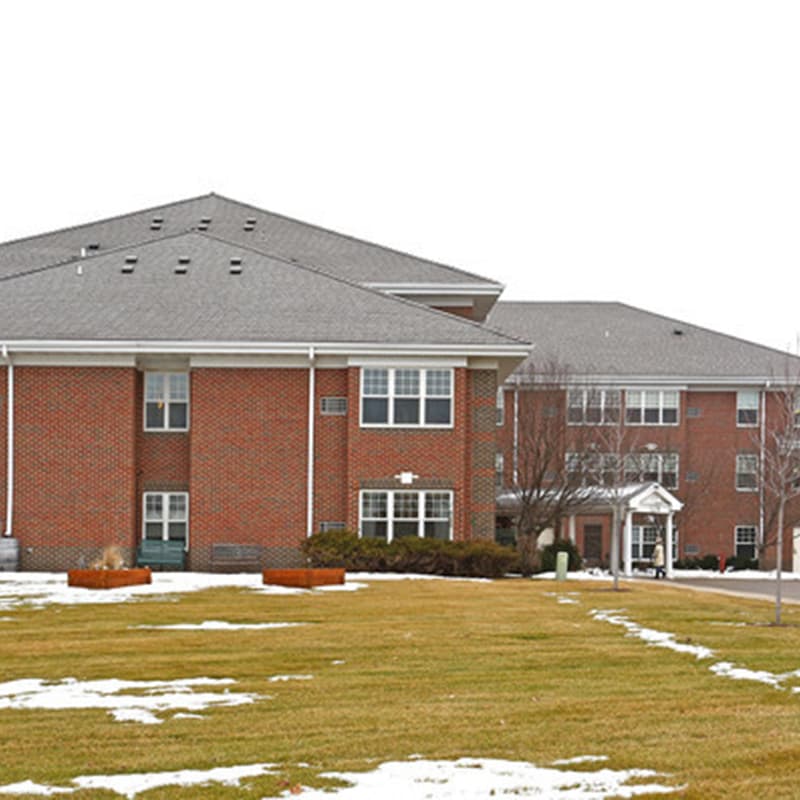
“As an apartment manager, I could say that the main reason for having a smoke-free building is the maintenance cost savings, and that’s it’s easier not to have to deal with tenant complaints and safety concerns about smokers. But the indisputable benefit for having a smoke free building is our Ebenezer senior apartment community’s objective to promote healthful and meaningful aging and the best possible quality of life.”
Denise Bierle-Svec
Property Manager of Ebenezer’s Ridge Point Apartments
Burnsville, MN
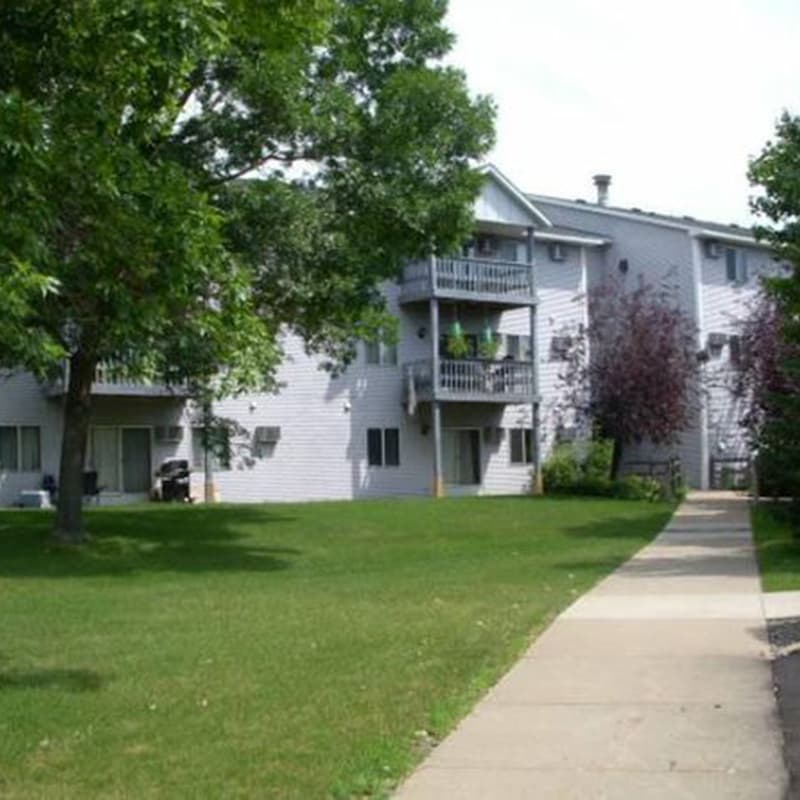
“When we began with our complex being a smoke free property I thought we were going to run into major problems with the residents. Actually it has been a very rewarding experience.
One resident that was a very heavy smoker we found out that she quit when the complex became smoke free. The maintenance tech was fixing something for her and he was having a conversation with her and asked her if she was having a hard time the going off the complex to smoke. She said no and that she had quit smoking because of it. The maintenance technician came back to me, the manager and told me of the conversation, so I decided to reward her with a congratulations note and keep up the good work. She replied with a note of her own, “Dear Staff of Walnut Place, I want to thank you for your card. Your words of praise and encouragement have meant a lot to me. Believe it or not, but I think the maintenance technician, Gary has been my greatest supporter in quitting! This means a great deal to me!” She also informed me when her year anniversary was for her quitting smoking and a thank you again for our encouragement. So now I have it along with others on my desk calendar when their anniversaries are and send the cards of praise. According to this one resident our encouragement was the only encouragement that she had received so it meant a lot to her. ”
Joanne Swanson
Property Manager of Walnut Place
Rockford, MN
